Air Training Corps
| Air Training Corps (ATC) | |
|---|---|
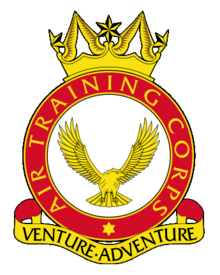 Corps Badge | |
| Founded | 5 February 1941 |
| Country | United Kingdom |
| Type | Volunteer Youth Organisation RAF |
| Size |
1,099 Squadrons 33,370 Cadets[1] 10,280 Adult Volunteers (at April 2017)[2] |
| Motto(s) | Venture Adventure |
| Commanders | |
| Commandant Air Cadets | Air Cdre. Dawn McCafferty RAF(R) |
| Honorary Air Commodore-in-Chief | HRH The Duchess of Cambridge |
| Insignia | |
| Ensign |
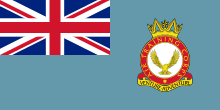 |
| Aircraft flown | |
| Trainer |
Grob Tutor Grob Viking |
The Air Training Corps (ATC) is a British volunteer-military youth organisation, sponsored by the Ministry of Defence and the Royal Air Force. The majority of staff are volunteers, and some are paid for full-time work[3] – including Commandant Air Cadets, a Full Term Reserve Service RAF officer, at the rank of Air Commodore.[4] Although many ATC cadets go on to join the RAF or other services, the ATC is no longer set up as a recruiting organisation.[5]
Activities include sport, adventurous training (such as walking and paddle-sports), ceremonial drill, rifle shooting, fieldcraft, powered aircraft and glider flying, and other outdoor activities, as well as classification training leading up to a BTEC in Aviation Studies. Week-long trips to RAF stations, or camps offering adventure training or music, allow the opportunity for cadets to gain a taste of military life and often to gain some flying experience in RAF gliders and RAF training aircraft such as the Grob Tutor.
Cadet membership can begin from the start of School Year 8 (England and Wales), or equivalent in Scotland and Northern Ireland. New members will join as a junior cadet (probationer) and can earn positions of increasing responsibility in a military rank structure, as well as having increasing skill and competence recognised in a classification scheme (First Class, Leading, Senior, Master and Instructor).
Service as a cadet ends at the age of 18, although cadets over the age of 18 can be extended until the age of 20 if appointed as a Staff Cadet.
In April 2017, the ATC numbered 31,190 cadets (29% female) and 10,280 adult volunteers (26% female).[2] In addition, there were several thousand civilian committee members.
Together with the RAF contingents of the Combined Cadet Force, the ATC form the Royal Air Force Air Cadets, formerly known as the Air Cadet Organisation,[6] part of the Community Cadet Forces.
History
Foundation
Air Commodore Sir John Chamier is affectionately known as the "father of the air cadet movement".[7] He joined the Royal Flying Corps (the forerunner of the Royal Air Force) where he served as a pilot in World War I, transferred to the Royal Air Force in 1918 and after retiring from the service in 1929, become Secretary-General of the Air League - an organisation made up of people who wanted to make the British public aware of the importance of military aviation. With the clouds of war beginning to form over Europe and the personal memory of how young men with only a few hours of training had been sent into air combat only to fall victim to well-trained enemy aviators, he conceived the idea of an aviation cadet corps.
Air Defence Cadet Corps
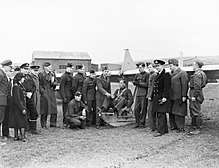
The purpose of the Air Defence Cadet Corps (ADCC), set up in 1938 by Air Commodore Chamier, was to train young men in various aviation-related skills.[8] The ADCC proved popular, with thousands joining up. In 1941, in order to provide the means of giving part-time air training to teenagers and young men who might later join the Royal Air Force, the ADCC was formally established as the Air Training Corps by Royal Warrant.
Air Training Corps
.jpg)
On 5 February 1941, the Air Training Corps (ATC) was officially established, with King George VI agreeing to be the Air Commodore-in-Chief, and issuing a Royal Warrant setting out the Corps' aims. Within the first month of its existence, the size of the old ADCC, now the ATC, virtually doubled to more than 400 squadrons and continued to grow thereafter. A new badge was designed for the ATC and, once approved by the King, was distributed in August 1941. The motto ' Venture Adventure ', devised by Air Commodore Chamier, was adopted by the ATC and incorporated into the badge.
The new ATC squadrons adopted training programmes to prepare young men for entry to the Royal Air Force. Squadrons arranged visits to RAF and Fleet Air Arm stations as part of the cadets' training, where a flight might be a possibility. Such opportunities were not widely available, however, and many cadets were disappointed. One solution was to introduce opportunities for gliding, as a way to allow a cadet to get the feel of an aircraft in flight and to handle an aircraft's controls whilst airborne. After the end of the Second World War, gliding lessons became available.[9]
Prior to the 1980s, females were unable to join the ATC, although they were able to join an attached unit of the Girls Venture Corps (GVC) which had been formed in the early years of the Second World War, if one was available at that location.[10] As of 2013, the GVCAC still exists, although in greatly reduced numbers due to competition from the ATC, and the two organisations no longer share a site.
Before May 2008, cadets would spend a lot of time in the classroom before obtaining First Class classification, studying the following subjects: The Air Training Corps, The Royal Air Force, History of Flight, Initial Expedition Training, Basic Communications and Airmanship I. After a number of lectures and when the cadet felt ready, they would take a multiple choice examination, either on paper or on a computer. Some wings ran courses that would involve the cadet spending a few solid days learning and then awarded the appropriate classification if successful in their exams. In May 2008, HQAC decided to change the training programme for junior and second class cadets, sensing that new recruits were being deterred by exams. In March 2016, after a review of the then current training syllabus, the new "Progressive Training Syllabus" was introduced, which provided for four levels of each badge (blue, bronze, silver, and gold).[11][12]

Air Cadet Organisation
Previously, advertising material such as leaflets and official websites brand the Air Training Corps and Combined Cadet Force together as the Air Cadet Organisation (or ACO), however, this is now the Royal Air Force Air Cadets (RAFAC). Members of the ATC may refer to themselves as Royal Air Force Air Cadets, although to the general population they are more commonly known as "Air Cadets".
Structure and organisation
The Air Training Corps has three distinct and separate parts – the officer and staff cadre (which comprises uniformed and civilian instructors), the Civilian Committee and the Chaplaincy.
The United Kingdom is split into six regions, each commanded by a retired Group Captain in the RAF Reserves, and having a Regional Chairman and Regional Chaplain. Each region is sub-divided into a number of wings. There were historically six wings per region, however, as of 2013 there were 34 wings, most named after the one or two counties of the United Kingdom that they operate in. Wings are further sub-divided into sectors. Within the sectors lie squadrons, and it is the squadron that is the focal point for the majority of members of the Corps. As of 2015 there were 1009 ATC squadrons and detached flights, each assigned to a wing.
The ATC is the largest part of the Royal Air Force Air Cadets (RAFAC), along with the RAF sections of the Combined Cadet Force. The RAFAC forms one of the seven functional areas of No 22 Group RAF, which is responsible for the recruitment and selection of all RAF personnel and for the policy and delivery of RAF non-operational training (including flying training).
Regions

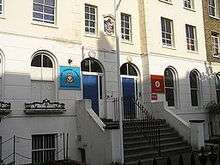
_Air_Training_Corps_in_Dale_Street._-_geograph.org.uk_-_864764.jpg)
_Sqn._-_geograph.org.uk_-_917529.jpg)
Wings
| Central & East[13] | London & South East[14] | North[15] | Scotland & Northern Ireland[16] | South West[17] | Wales & West[18] |
|---|---|---|---|---|---|
| Bedfordshire & Cambridgeshire Wing | London Wing | Central & East Yorkshire Wing | North East Scotland Wing | Bristol & Gloucestershire Wing | Merseyside Wing |
| Hertfordshire & Buckinghamshire Wing | Kent Wing | Cumbria & Lancashire Wing | South East Scotland Wing | Devon & Somerset Wing | No. 1 Welsh Wing |
| Norfolk & Suffolk Wing | Essex Wing | Durham & Northumberland Wing | West Scotland Wing | Dorset & Wilts Wing | No. 2 Welsh Wing |
| South & East Midlands Wing | Middlesex Wing | Greater Manchester Wing | Highland Wing | Hampshire & Isle of Wight Wing | No. 3 Welsh Wing |
| Trent Wing | Surrey Wing | South & West Yorkshire Wing | Northern Ireland Wing | Plymouth & Cornwall Wing | Staffordshire Wing |
| Warwickshire & Birmingham Wing | Sussex Wing | Thames Valley Wing | West Mercian Wing |
National
Headquarters Air Cadets (HQAC) is based at RAF Cranwell in Lincolnshire. There are subordinate headquarters at region and wing levels, staffed by adult officers [note 1] and civil servants. HQAC controls two Air Cadet National Adventure Training Centres – at Llanbedr, Gwynedd, Wales and Windermere, Cumbria, England, which provide a range of adventure training courses and accommodation for squadron and wing expeditions. HQAC also controls (as of 2018) ten Volunteer Gliding Squadrons around the UK, through the Air Cadet Central Gliding School at RAF Syerston, and twelve Air Experience Flights.
Local
ATC Squadrons are established in most large towns in the United Kingdom. There are also units in Cyprus, Germany, Gibraltar and the Channel Islands. In towns not large enough to sustain a squadron of 30 cadets, or as a supplement to an existing squadron in a larger town or city, a Detached Flight (DF) may be formed. A detached flight operates much like any other unit, but is technically a component part of a nearby, larger squadron. As of March 2013 there were over 900 ATC squadrons and 32 detached flights.[19]
Commanding Officers receive a Cadet Forces commission, introduced in 2017 and restated in 2018.[20] Squadrons were previously commanded by a Royal Air Force Volunteer Reserve (Training Branch) RAFVR(T) officer, or sometimes a warrant officer. The commanding officer has a good deal of autonomy in running his or her unit, along with the responsibility that goes with it. Where a unit has other members of staff, the commanding officer allocates duties and provides recommendations on appointments, retentions and promotions. A Commanding Officer of an ATC Squadron can appoint Cadets up to the rank of Cadet Flight Sergeant (Cdt FS) without any external approval. Further Cadet promotion to the rank of Cadet Warrant Officer (CWO) requires recommendation being sent to their Squadron's Wing HQ.
The Squadron Warrant Officer (Sqn WO) commonly holds the rank of warrant officer, or may be a senior non-commissioned officer (SNCO) if no warrant officer is available, and will typically have spent many years working within the squadron or at least within the ATC. In the case where no commissioned officers are present, the Sqn WO or SNCO will take charge of the unit. The squadron warrant officer usually has a closer relationship with the cadets than the commanding officer.
The establishment of officers, WOs, senior NCOs and cadet NCOs is dependent on the size of the squadron or detached flight and this basic structure has many permutations – varying with the number of cadets and staff, accommodation and facilities. A typical small detached flight may consist only of the Officer Commanding and fifteen cadets and is often housed in rented accommodation. At the other end of the scale, a large squadron can consist of 120 cadets or more, four commissioned officers, two non-commissioned officers and a half-dozen civilian instructors. Civilian instructors (many of whom are retired RAF regulars) form the backbone of the ACO.
Civilian committees
A Civilian Committee (or Civcom) underpins all local funding that the RAF cannot provide beyond core services for the squadron. Each is an independent charity and operates in partnership with the local squadron which is under the control of the commanding officer. Since the uniformed officers and civilian instructors in the ATC have no financial responsibilities, but still need money to manage and provide cadet activities such as annual and overseas camps and adventure training, the civilian committee is financially responsible. There is no rank structure in civilian committees, nor are its members beholden to anyone. Serving as trustees, they are unpaid volunteers who support the cadet activities financially leaving the paid uniformed officers to deliver the cadet experience.
The RAFAC (ATC) is itself not a charitable organisation and has been established as being a non-legal entity. For this and other reasons, the Civilian committees are required to be responsible for, and accountable for, the charitable fundraising of the squadron. As with any charity, three officers (Chairperson, Secretary and Treasurer) are elected at an AGM, possibly with the addition of a deputy Chairperson, and then exist as an independent group to raise and manage funds in a lawful manner in accordance with the Charities Act. They do this under the status of an 'excepted charity' which requires that they conduct themselves wholly to the Charities Act 2011 but are excepted from sending in annual reports to the Charity Commission.
The squadron commander and chaplain are ex-officio members of their civilian committee and have no voting rights, however common-sense determines they may advise in squadron-related matters. While co-operation between the squadron and the civilian committee is desirable at all times, there is no line of command or authority of anyone other than the trustees of the civilian committee. This includes any uniformed personnel up to, and including, the Commandant Air Cadets.
A civilian committee is responsible for overseeing the initial unit formation and direction and will monitor the welfare of cadets. Civilian committees often include parents of cadets and retired ATC staff. Many squadron charities decide to operate against the RAFAC document known as ACP-11 which has been the traditional constitution. However, there is no requirement to do so as long as the civilian committee establishes a constitution with acceptable charitable object statements; these may be similar to those in ACP-11 but offers the advantage of more local definition in deciding the use of funds.
The most recent revision of ACP-11 was conceived as a means of retaining control for the organisation over civilian committees through what is known as the Association Model of trusteeship. The document is controversial and has been questioned by experienced trustees in charitable work on the basis that it is confused and almost certainly contradicts charity law. Furthermore, to be a lawful and binding constitution for a squadron, it must be adopted autonomously by the trustees of each civilian committee and not released as an automatic update in the manner of all other ACP revisions.
Although there is no hierarchy, there are links that tie the organisation together structurally. Those that form the uniformed chain of command are self-explanatory. For civilians however, these links are formed of upward provision of trustees. So, from the civilian committees within a number of squadrons is elected a Wing chairperson to serve as a trustee of the Wing charity. In theory, the same happens from Wing to Region however, there has been a change in recent years where these positions have been appointed rather than by bona-fide election.
Any civilian committee in England and Wales that has an annual income that exceeds £5,000 in any one year, may register their charity with the Charity Commission. The charity commissions of Scotland and Northern Ireland require committees located in those countries to register and have done so for several years.
The role of a civilian committee also extends to cadet welfare and this can be a sensitive area at times. Cadets who feel unhappy or experience bullying, or who have safeguarding issues should be able to approach members of the civilian committee in confidence to discuss their concerns. Depending on the nature of the issue at hand, relationships may become strained where it is felt that commanding officers are not implementing the set procedure in such matters as the rule book (another ACP) prescribes.
Culture
Aims and motto
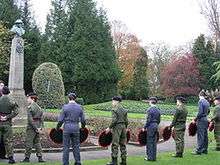
The Aims of the Air Training Corps, as set out in the Royal Warrant and approved by HM the Queen, the British sovereign, are:
- To promote and encourage among young men and women a practical interest in aviation and the Royal Air Force (RAF).
- To provide training which will be useful in both the services and civilian life.
- To foster a spirit of adventure and to develop the qualities of leadership and good citizenship.[21]
The corps motto is "Venture, Adventure".[7]
In late December, HRH The Prince Phillip resigned from his role as honorary Air Commodore-in-Chief - having served in this role since 1953. It was announced on 16 December 2015 that HRH Prince Philip, Duke of Edinburgh is being succeeded as honorary Air Commodore-in-Chief by The Duchess of Cambridge.[22]
Oath
Upon enrolment into the ATC, every cadet has to make the following promise, usually at a ceremony presided over by the unit's padre or commanding officer:
- "I, *Full Name*, hereby solemnly promise on my honour to serve my Unit loyally and to be faithful to my obligations as a member of the Air Training Corps. I further promise to be a good citizen and to do my duty to (God and^) the Queen, my Country and my Flag."[23]
This promise is recorded by the cadet's signature in his or her Cadet Record of Service Book (RAF Form 3822)
(^ The promise has recently been rewritten to accommodate everyone, whether or not they are religious.)
Ensign

The Air Training Corps Ensign is hoisted for every parade in the summer and hauled-down at dusk. It is expected that it should be treated with the same respect and dignity afforded to the Royal Air Force Ensign. In the event of poor weather conditions e.g. heavy rain or snowfall, the ensign would not be raised. If poor weather conditions are present whilst the ensign is raised, it would be hauled down at the soonest possible point. This is to avoid damage to the ensign and also as a mark of respect and discipline.
The ATC ensign is raised and lowered by a nominated member of the squadron, sometimes a cadet non-commissioned officer (NCO), member of staff, or simply a cadet who has been chosen, with the salute being taken by any commissioned officer, normally the squadron's Officer Commanding. All officers within view or earshot of the ensign are expected to salute during the hoisting and hauling down.
Most ATC wings and squadrons also have a banner, in addition to an ensign, which is paraded on formal occasions. The ATC also has a Corps Banner, which is afforded the same courtesies as an RAF Squadron Standard or the RAF Queens Colour, although its status is different.
Uniform

All cadets are issued with a uniform that is similar to that worn by RAF personnel and are regulated by similar dress regulations to the RAF. The Air Training Corps' dress regulations can be found in AP1358C. Occasionally alterations have been made to the dress regulations as the organisation has developed over the years. One such example being the authorisation CFAVs and Cadets to wear Multi-Terrain Pattern (MTP) uniform in 2014.
The standard uniform consists of a dark blue shirt and brassard, blue-grey trousers (male cadets) or skirt/slacks (female cadets), a blue-grey jumper: V-neck or round neck version, to be worn when required, and an RAF blue beret with the Air Training Corps cap badge.
Some Squadrons differentiate themselves from each other at a local level. One such example would be different coloured pieces of cloth behind the cap badges on the beret. This allowed Cadet NCOs and CFAV to distinguish between Cadets of differing Flights. This practise, however, is not officially authorised from HQAC and therefore should not be practised. All uniform except black parade shoes and combat boots are provided at the expense of the ATC. Girls are also expected to provide their own hair nets, hair spray, hair ties etc. In order to keep it neat as well as 15 denier, matt, tights in the shade barely black. Boys hair must be kept short and tidy, above the collar and clear of the ears, although some squadrons are now allowing long male hair to be tied in the same fashion as the girls, however, this is not widespread, plain black socks are also required.
Cadets are also issued with a light blue shirt and tie for formal occasions, and are usually either issued with or privately acquire a camouflage uniform, also known as a disruptive pattern material (DPM) uniform and more recently have been authorised to wear the modern Multi-Terrain Pattern (MTP). Cadets may be allowed or obliged to wear other specialist uniforms, such as flight suits or other forms of protective clothing, when required.
Squadron insignia
The first 50 squadrons that were formed retain an F to show they are "founder" squadrons, e.g. 10F (Luton Airport) Squadron or 1F (City of Leicester) Squadron. Only 30 of these are still in existence; the other 20 have disbanded over time. Some founder squadrons have reformed under Roman numerals, having been refused permission to re-assume the F; the first Squadron to do so was XIX (19 Crawley) Squadron, Sussex Wing. Although Brooklands Squadron was the first Squadron to be established, it was given the Squadron number of 11F due to a clerical error.
A Detached Flight uses its parent squadron number followed by the letters DF to show that it is a detached flight e.g. No 1408DF for No 1408 (Cranleigh) Detached Flight, raised by No 1408 (Dorking) Squadron.
Activities
.jpg)
There are also opportunities for band music and many camps offer teenagers the chance to spend a week away from parents practicing fieldcraft or receiving instruction in gliding and other outdoor pursuits. Many of these activities, including gliding, have a well-defined scale of achievement that a cadet can work to build up; this includes the leadership qualities reflected in an NCO structure.

Annual camps

The ATC runs numerous annual camps each year, run on RAF stations so that cadets may get a taste of service life. Annual camps are organised at wing level with place for all squadrons, so that every cadet who wishes to and who has achieved at least the First Class qualification may take part. Cadets usually stay in RAF barrack blocks and eat in the station's mess facilities. The itinerary is always packed with typical ATC activities such as air experience flying, shooting, adventure training and, of course, drill. Cadets also have the opportunity to visit various sections of the station and meet the people who work there.
Cadets may also have the opportunity to attend other sorts of annual camp, such as a locally (i.e. wing- or squadron-) organised camp based around adventure training or fieldcraft, or as guests on a camp run by one of the other cadet forces such as the Army Cadet Force or the Sea Cadet Corps. There are also Music camps for band members.
The largest camp of all is the Royal International Air Tattoo (RIAT) camp held annually in July at RAF Fairford. Each year more than 1,500 cadets and their staff spend between 1 and 3 weeks doing essential work in the preparation and the taking-down of the infrastructure of RIAT.[24] On display days cadets have jobs to do and after the show weekend they are able to meet the crews and see the aeroplanes at close range.
Work experience camps
Another option for more senior cadets are work experience camps. Whilst annual camps aim to give cadets a general taste of service life, the work experience camps cater for cadets who are interested in a specific trade, such as the RAF Regiment or RAF Police. However, in recent years, the opportunities for work experience placements have decreased. Cadets can, however, contact their local Armed Forces Careers Office (AFCO).
Overseas camps
For older and more experienced cadets who have achieved the Leading Cadet qualification and have attended a UK Annual Camp, the corps also offers overseas camps. These are generally more relaxed and seen as a reward for hard-working and long-serving cadets. Since the end of the Cold War, and the closure of RAF stations in Germany, the number of overseas camp opportunities has decreased. As of 2007 the destinations for overseas camps are:
- RAF Akrotiri on Cyprus. A 7-day camp over the Easter school holiday period and at select other times of the year.
- RAF Gibraltar in Gibraltar.
- Sennelager Training Area in Germany
- JHQ Rheindahlen in Germany.
- USAF Ramstein in Germany. A camp at the base during the summer.
- International Four Days Marches in Nijmegen, The Netherlands, annually in July, where cadets complete a 165 kilometres (103 mi) walk over 4 days.
Former RAF bases that hosted overseas camps included RAF Laarbruch, RAF Gütersloh, and RAF Gatow.
Corps-wide Trophies
ATC squadrons each have a chance annually to win the two most prized trophies in the corps. The Sir Alan Lees trophy is awarded by the ATC commandant to the squadron with the best statistics and overall impression when inspected. The Morris Trophy is awarded to one of the 6 regional candidates upon inspection by the commandant.
| 1952 | No. 187 (Worcestershire) Squadron, West Mercian Wing | Squadron Leader Charles Baynton-Hughes MBE RAFVR(T) |
| 1971 | No. 187 (City of Worcester) Squadron, West Mercian Wing | Squadron Leader Charles Baynton-Hughes MBE RAFVR(T) |
| 1976 | 176 (Hove) Squadron, Sussex Wing | Flt Lt F P Le Duc MBE RAFVR(T) |
| 2000 | No. 230 (Congleton) Squadron, Staffordshire Wing | Flight Lieutenant Rod Goodier RAFVR(T) |
| 2001 | No. 215 (City of Swansea) Squadron, No.3 Welsh Wing | Squadron Leader Phillip Flower MBE RAFVR(T) |
| 2005 | No. 215 (City of Swansea) Squadron, No.3 Welsh Wing | Squadron Leader Phillip Flower MBE RAFVR(T) |
| 2008 | No. 241 (Wanstead and Woodford) Squadron, London Wing | Squadron Leader Jerry Godden RAFVR(T) |
| 2009 | No. 610 (Chester) Squadron, Merseyside Wing | Flight Lieutenant John Kendal RAFVR(T) |
| 2010 | No. 1475 (Dulwich) Squadron, London Wing | Squadron Leader Kevin Mehmet MBE RAFVR(T) |
| 2011 | No. 215 (City of Swansea) Squadron, No. 3 Welsh Wing[25] | Squadron Leader Phillip Flower MBE RAFVR(T) |
| 2012 | No. 2160 (Sleaford) Squadron, Trent Wing | Flight Lieutenant Mel Walker RAFVR(T) |
| 2013 | No. 2344 (Longbenton) Squadron, Durham & Northumberland Wing [26] | Flight Lieutenant Gary Richardson RAFVR(T) |
| 2014 | No. 1349 (Woking) Squadron, Surrey Wing | Flight Lieutenant Ben White RAFVR(T) |
| 2015 | No. 56 (Woolwich) Squadron, London Wing | Flight Lieutenant Mark Bird RAFVR(T) |
| 2016 | No. 31 (Tower Hamlets) Squadron, London Wing | Flight Lieutenant Rex Nicholls RAFVR(T) |
| 2017 | No. 187 (City of Worcester) Squadron, West Mercian Wing | Flight Sergeant (ATC) Karl Nicholson |
| Year | Winner | Officer Commanding |
|---|---|---|
| 1978 | 176 (Hove) Squadron, Sussex Wing | Flt Lt F P Le Duc MBE RAFVR(T) |
| 1997 | No. 2465 (Luton Icknield) Squadron, Beds and Cambs Wing [27] | Flight Lieutenant P R Smith RAFVR(T) |
| 2006 | No. 2409(Halton) Squadron, Herts and Bucks Wing[28] | Squadron Leader Jerry Davies RAFVR(T)[28] |
| 2008 | No. 1855 (Royton) Squadron, East Lancashire Wing | Flight Lieutenant Mark Hamilton RAFVR(T) |
| 2009 | No. 1211 (Swadlincote) Squadron, South and East Midlands Wing | Flight Lieutenant Alyn Thompson RAFVR(T) |
| 2010 | No. 126 (City of Derby) Squadron, South and East Midlands Wing | Squadron Leader Ian Marshall RAFVR(T)[29] |
| 2011 | No. 1855 (Royton) Squadron, East Lancashire Wing[25] | Flight Lieutenant Mark Hamilton RAFVR(T) |
| 2012 | No. 633 (West Swindon) Squadron, Dorset & Wiltshire Wing | Flight Lieutenant Helene Woodham RAFVR(T) |
| 2013 | No. 2516 (Droitwich) Squadron, West Mercian Wing [30] | Flight Lieutenant Paul Wilde RAFVR(T) |
| 2014 | No. 184 (Manchester South) Squadron, Greater Manchester Wing | Flight Lieutenant Tom Warner RAFVR(T) |
| 2015 | No. 1271 (Bathgate) Squadron, West Scotland Wing | Flight Lieutenant Margaret Greer RAFVR(T) |
| 2016 | No. 126 (City of Derby) Squadron, South and East Midlands Wing | Squadron Leader Ian Marshall MBE RAFVR(T) |
| 2017 | No. 1211 (Swadlincote) Squadron, South and East Midlands Wing | Flight Lieutenant Ruth Morgan RAFVR(T) |
The Foster Trophy is awarded to the cadet who has achieved the highest academic results in the entire corps over his/her time in the ATC, after finishing the cadet syllabus that leads to a BTEC Level 2 Certificate in Aviation Studies. In addition, there are also trophies presented annually by the Royal Air Forces Association. These trophies include the "Sir Douglas Bader Wings Appeal Trophy" for the ATC squadron collecting the most money on a per capita basis, The squadron achieving second place is awarded the “Sir Augustus Walker Trophy". The “Sir Robert Saundby Trophy” is awarded for collecting the highest net Wings Appeal amount.
The Quinton Memorial Trophy is a national award presented annually to the adult non-commissioned officer who has gained the top academic results in the senior non-commissioned officer initial courses held at the Air Cadet Adult Training Facility, Royal Air Force College, Cranwell. This trophy is named in honour of Flight Lieutenant John Quinton.[note 2]
Cadet Ranks
Cadets
Young people who have begun their 2nd year of Secondary School (Year 8) and are under 16 3/4 years old can join the ATC. They are initially given the title 'Junior Cadet' and can go along to most meetings to get a feel for the ATC. Enrolment confers the status of Second Class Cadet and upon completion of the First Class syllabus, they become First Class Cadets and receive their First Class badge to be worn on their brassard. First class classification can take 3 to 6 months to reach, depending upon the squadron's activities and schedule. Once cadets have successfully completed lessons in a number of subjects and achieved first class classification, they are able to take part in almost all ATC activities. Those who stay on beyond 18 are known as Staff Cadets and wear rank slides denoting such. All cadets over the age of 18 must complete AVIP (Adult Volunteer Induction Programme) prior to their 18th birthday and must be DBS cleared. Once a Cadet has completed the AVIP, and subject to approval from the Cadet's Wing Commander their Cadet service is extended to their 20th birthday. After this point Cadet service is terminated.
All cadets are issued with a uniform and must each pay a small amount in subscriptions (or 'subs' as they are commonly known), usually around £50–£100 per year, although this can vary widely from squadron to squadron. Activities such as small and full-bore target rifle shooting, flying and gliding are paid for from the budget of the Royal Air Force.
Cadet Non-Commissioned Officers (NCOs)
As cadets become more experienced, and if suitable, they can be promoted by their squadron's commanding officer (CO) to the status of cadet NCOs. Promotion to the rank of corporal, sergeant and flight sergeant is at the discretion of the Commanding Officer. They (or a representative) will make a decision based on merit and leadership potential – many squadrons have formal selection procedures including interviews, whilst others select by observing potential during normal training. All cadets, regardless of rank, must leave by age 20.
The NCO ranks within the ATC mirror those of the RAF's non-technical/flying trades and are, in ascending order of seniority:
 |
Cadet Corporal (Cpl) |
 |
Cadet Sergeant (Sgt) |
 |
Cadet Flight Sergeant (FS) |
 |
Cadet Warrant Officer (CWO) |
It is common within the ATC to abbreviate these ranks by dropping the prefix "cadet". Cadet Warrant Officers are not addressed as Sir/Ma'am, but as one of two ways. The preferred "Cadet Warrant" or “Warrant Officer”. This is the only rank in the Corps to accommodate the “Cadet” prefix into it upon being referred to by members of the Corps.[31] This is to distinguish them from the Adult Staff, as they are at least 18 years of age and could easily be confused with an adult member of staff, or a serving member of the RAF.
Promotion to Cadet Warrant Officer is decided by a panel at wing level once a recommendation form has been submitted by the Officer Commanding of the prospective candidate's Squadron. Prospective candidates will be a Staff Cadet Flight Sergeant, preferably holding the Master Cadet classification (see below) and will be required to attend an interview with the wing commander or his/her representative. Once the Wing Commander approves the promotion to Cadet Warrant Officer, the recommendation is sent to HQAC at RAFC Cranwell. The recommendation will then receive final approval and a certificate of appointment will be issued to the successful candidate.
Staff cadets
All cadets who are over the age of 18, must complete an "AVIP" (Adult Volunteer Induction programme) and will have the prefix "Staff Cadet" before their rank. These cadets wear a rank slide with the words 'STAFF CADET' embroidered below their rank insignia (or on plain slides for those of cadet rank). A staff cadet has extra responsibilities over cadets who are under the age of 18, including a duty of care to younger cadets and NCOs. These cadets have also hold enhanced Disclosure Barring Service Certificates in the same way as adult staff.
Staff cadets are considered adult members of staff after this point so are segregated from the cadets in accommodation and washing facilities.
Cadet Classification Syllabus
Not all cadets who join the ATC can expect to receive promotion. However, all cadets can progress through the training system and, by passing exams, achieve different classifications. The classification levels are Junior Cadet, Second Class Cadet (this is automatically achieved on enrolment), First Class Cadet, Leading Cadet, Senior Cadet and Master Air Cadet. In order to achieve these qualifications, cadets study a variety of subjects through tuition from the instructors and/or self-study from Ultilearn. Each successive qualification generally allows a cadet greater participation in ATC activities. Cadets who have achieved the Master air cadet classification have completed their academic training and can attain a BTEC Level 2 in Aviation Studies (Equivalent to 2 GCSEs A*-C).
Instructor Cadet is not a classification as such, but rather a qualification. Cadets need to be at least 16 years of age to take part in this one day course, which allows them to teach other cadets. Although this is not compulsory, ATC Wings ordinarily feed this hand-in-hand with the Staff Cadet Course (see below). Upon successful completion of this course, the cadet will be awarded a yellow lanyard to distinguish them. This is worn over the left shoulder and fastened to a small black Royal Air Force button or the left shirt pocket button when not wearing a jumper.
Marking methodology
Leading Cadet, Senior Cadet and Master Cadet exams consist of assessment criteria each containing two questions. A cadet must achieve either 1 or 2 marks (50% or 100%) for each module in order to pass. All exams are now taken online on a system called Ultilearn.
First Class Cadet
First Class is also commonly referred to as 'Basic Training'. A variety of methods are used to test a cadet's understanding of the subject, including practical tests and exercises to test ability, and interviews/quizzes to test knowledge. All junior cadets also have to pass a practical Drill Test to become first class. The drill test is a sequence of simple drill manoeuvres essential for forming squads and a good foundation to build on for more advanced drill.
Leading Cadet
For a cadet to become a leading cadet, they must have already gained first-class status. They will then have to complete 3 examinations: Navigation on Land using a map and compass, Principles of Flight and Airmanship Knowledge.
Senior and Staff Cadet (old syllabus)
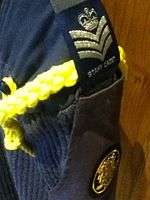
Prior to September 2010, for a cadet to become a senior cadet, they had already to have gained leading cadet status and taken 2 exams from a choice of 8 subjects, examined in the same way as for the Leading cadet syllabus. The 8 subjects were: Air Navigation, Pilot Navigation, Satellite Communications, Propulsion, Airframes, Advanced Radio and Radar, Aircraft Handling and Operational Flying.
The highest academic classification was Staff Cadet. For a cadet to become a staff cadet, they had to have already gained Senior Cadet status, be 15 years old, and to have sat and passed two more exams from the same subject list as for Senior classification, along with an interview with a wing staff officer and an assessment of teaching a lesson they would then be awarded their yellow lanyard.
Senior and Master (new syllabus)
In September 2010, a new classification structure, syllabus and examination process came into force. The following subjects are available: Piston Engine Propulsion, Jet Engine Propulsion, Rocketry, Aircraft Handling and Flying Techniques, Air Power, Airframes, Avionics and Aircraft Electrical Systems, Military Aircraft Systems, Basic Air Navigation, Basic Principles of Pilot Navigation, Advanced Radio and Radar, and Data Communications. Master Air Cadet has its own new badge for the brassard which shows an ATC Falcon surrounded by laurel leaves.
Specialist Instructor and Leadership Qualifications
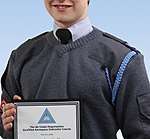
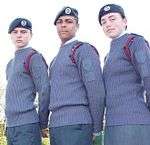
With the change of the classification structure in September 2010 the classification of staff cadet changed to become Instructor Cadet. An Instructor Cadet is denoted by a yellow lanyard worn over the left shoulder. Only Master Cadets will be permitted to wear the yellow lanyard. Whilst being a Master Cadet, there must also be a necessary Method Of Instruction Course which then grants the ability to wear the lanyard.
Alongside Instructor Cadet there is another lanyard that can be awarded to cadets who are interested in specialising in teaching aerospace subjects. These qualified cadets are known as Qualified Aerospace Instructors (QAIs) and wear a light blue lanyard over the left shoulder. The Qualified Aerospace Instructors Course (QAIC) has been running since September 2008. The course is held at RAF Linton-On-Ouse and as of 2011 also at MOD Boscombe Down. The course is held from early September to Easter of the following year, beginning with a selection weekend in early September, and 7 total weekends (as of QAIC 8, prior to this there were only 6 training weekends) from late September until early March.[32] The course culminates in a 'Graduation Week' which is organised to coincide with the Easter holidays to avoid clashing with school programmes. After completing training in various modules they carry out an assessed lesson, earning the blue QAIC lanyard and flight suit badge. Along the way the achievements of the students have been recognised by the Institute of Leadership and Management who offer an ILM Level 2 Certificate to graduating students and by the Royal Aeronautical Society who offer affiliated membership.[33]
For those interested in fieldcraft teaching and leadership there is the Junior Leaders Course. Successful completion of the course awards the participant a maroon lanyard to be worn over the left shoulder and a junior leaders badge to sew on to the left sleeve of their No.3 Service Dress (field uniform) to show they are a qualified Junior Leader. The course runs from September to Easter, involving nine weekend training camps and an assessment week. The course is aimed at more senior cadets, and as such an age restriction of 17 years applies. Not only this, but the course also requires the participant to hold the rank of Cadet Sergeant or higher. The course is also open to Sea Cadets and Army Cadets and culminates in the award of a Level 3 Certificate[34] in Leadership & Management from the Institute of Leadership and Management.[35][36]
Adult staff and ranking
Three categories of staff run the ATC at the unit level: commissioned officers, senior NCOs, and civilian instructors (CIs). All uniformed staff must attend training courses run by the RAF at the ATC Adult Training Facility, RAF College Cranwell (ATF), usually within a year of appointment, with further courses as they progress up the rank structure. Commissioned officers formerly wore a gilt 'VRT' pin upon their rank braid to denote being commissioned officers of the Volunteer Reserve (Training Branch), while Warrant Officers and NCOs wore a gilt 'ATC' pin. Both officers and NCOs wear embroidered rank slides with the lettering 'RAF AIR CADETS', and on No. 1 Service Dress officers and NCOs wear gilt 'RAF AC' pins to reflect the new RAFAC/Cadet Forces Commission.
| Commissioned Officers | Insignia | Non-commissioned Officers | Insignia | Civilian Staff | Insignia |
|---|---|---|---|---|---|
| Officer Cadet (Off Cdt)
RAFVR(T) |
 |
Sergeant Sgt (ATC) | .gif) |
Civilian Instructor (CI) | None normally worn, although may be seen with a lapel pin or an armband, or may be wearing a sweatshirt or polo shirt with a logo. |
| Pilot Officer (Plt Off)
RAFVR(T) |
.png) |
Flight Sergeant FS (ATC) |  |
Chaplain | None normally worn, although may be seen with a lapel pin |
| Flying Officer (Fg Off)
RAFVR(T) |
.png) |
Warrant Officer WO (ATC) | 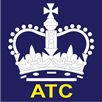 |
||
| Flight Lieutenant (Flt Lt)
RAFVR(T) |
.png) |
Warrant Officer* WO (ATC) | .jpg) |
||
| Squadron Leader (Sqn Ldr)
RAFVR(T) |
 |
The ATC pin worn on the
bottom of shoulder rank slides and lapels of those that are NCO's (ATC). |
 |
||
| Wing Commander (Wg Cdr)
RAFVR(T) |
 |
The VRT pin worn on the
shoulder rank slides and lapels of those that are RAFVR(T) officers. |
 |
||
| Group Captain (Gp Capt) | 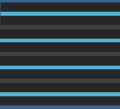 |
||||
| Air Commodore (Air Cdre) |  |
Officers
Officers were commissioned into the Training Branch of the Royal Air Force Volunteer Reserve - the RAFVR(T). The RAFVR(T) is non-combatant and there is no training for any form of active duty, or integration into the duties of other full-time or reserve duties. The RAFVR(T) officer is concerned only with the Air Cadets. Unless an officer has previous service, he or she is commissioned as a substantive Pilot Officer, termed Officer Cadet until the Officers Initial Course (OIC) at RAF Cranwell is completed.[note 3] Promotion to Flying Officer normally occurs after two years. Former regular commissioned officers usually start at Flying Officer, subject to certain conditions being met. Upon becoming Officer Commanding of a squadron, completing an Officers' Senior Course (OSC) and subject to certain conditions being met, the rank of Flight Lieutenant is bestowed.
As of December 2017, VRT Officers had their commissions transferred to the new Cadet Forces Commission (CFC) and ranks framework.[37][6]
Squadrons are usually commanded by CFC Flight Lieutenants, who are also found as Wing and Regional staff officers along with Squadron Leaders and Wing Commanders. Particularly large squadrons are sometimes commanded by Squadron Leaders (usually when the squadron has 100 or more cadets).
Commonly, the most senior rank in the Cadet Forces Commission is that of Wing Commander, but most recently the ambassador to the Air Cadets will be appointed to the honorary rank of Group Captain in the CFC.
| Commissioned Officers | Insignia |
|---|---|
| Officer Cadet (Off Cdt)
RAFAC |
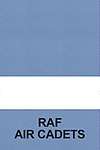 |
| Pilot Officer (Plt Off)
RAFAC |
 |
| Flying Officer (Fg Off)
RAFAC |
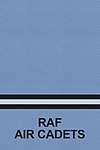 |
| Flight Lieutenant (Flt Lt)
RAFAC |
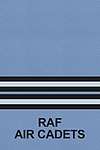 |
| Squadron Leader (Sqn Ldr)
RAFAC |
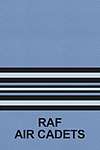 |
| Wing Commander (Wg Cdr)
RAFAC |
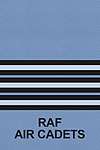 |
| Group Captain (Gp Capt) | 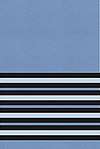 |
| Air Commodore (Air Cdre) |  |
NCOs and WOs
Adults may also be appointed as senior NCOs, these being ranks within the ATC. Adult NCOs/WOs are uniformed in the same way as their RAF counterparts with two exceptions: a small gilt ATC badge is worn on the rank badge and Warrant Officers wear a different rank badge (unless they have previous regular or active reserves warranted service). The ranks of Adult NCOs/WOs are Sergeant (ATC), Flight Sergeant (ATC) and Warrant Officer (ATC).[note 4]
As of December 2017, ATC SNCOs and WOs had their ranks transferred to the new RAFAC commissions and ranks framework.[37][6]
| Noncommissioned Officers (NCOs) | Insignia |
|---|---|
| Acting Sergeant (ASgt) RAFAC | 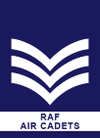 |
| Sergeant (Sgt) RAFAC / Sergeant aircrew RAFAC^ | 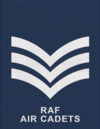  |
| Flight Sergeant (FS) RAFAC / Flight Sergeant aircrew RAFAC^ |  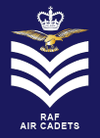 |
| Warrant Officer(WO) RAFAC / Warrant Officer aircrew RAFAC^ | 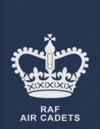 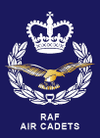 |
| Warrant Officer* (WO) RAFAC / Master aircrew (MAcr) RAFAC^^ | 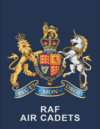 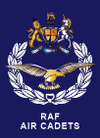 |
*Ex-regular Warrant Officer, Regional & Corps Warrant Officers, or (formerly) granted to other ATC WO's for long service.
^ - Adult Staff who are working in Aircrew roles, such as at Volunteer Gliding Squadrons or at Air Experience Flights are authorised to wear the Aircrew insignia for their rank accordingly.
^^ - Ex-regular Master Aircrew
Civilian instructors and chaplains
Civilian Instructors, known as CIs, play an important role in training cadets and, in many ways, are the 'backbone' of the Squadron. Unlike adult NCOs and Officers, CIs do not wear a uniform, although until recently greens were acceptable for fieldcraft and shooting activities, flying suits are still to be worn by those serving on AEF's or VGS', for safety reasons, which override other dress regulations. CI's do not officially form part of the chain of command in the squadron, but they may hold what might be called Command posts. It is expected that any cadet, irrespective of rank, should and will listen to CI's and obey relevant instructions given. A Civilian Instructor's recognised dress consists of a light blue polo shirt and dark blue sweatshirt bearing the name of the corps and "Royal Air Force", in an effort to standardise the means by which CIs are identified. CI's are addressed as Sir or Ma'am by cadets when speaking to them or Mr, Mrs, Miss then surname by staff speaking to them or by anyone who is referring to them when they are not present, neither "CI" and surname nor "staff'" are correct forms of address. Staff is the term of address for service personnel junior to NCO rank.
Many CIs are ex RAF or ex military or have skills that complement the aims of the ATC.
Some CIs may hold positions such as the Squadron Adjutant or Training Officer within the squadron.
Similarly, ATC chaplains are usually civilian members of the local clergy (although forces chaplains may join as Service Instructors). The role of an ATC chaplain is to 'provide appropriate pastoral care for all personnel within the Air Cadet Organisation irrespective of religious belief or status[39]'. A chaplain's role in the local squadron is to offer guidance and leadership to cadets and members of staff on moral and spiritual matters. The commitment expected of a chaplain is a monthly visit to lead what is termed 'the Padre's hour' and to conduct the formal Enrolment Service when new cadets join. ATC chaplains are supported by the RAF Chaplain's Branch[39]. ATC Chaplains do not wear uniform but are recognised by a Chaplain's badge on their lapel and a larger version on their preaching scarf[39]. Even if it is not their custom to do so, ATC chaplains are expected to wear a clerical collar when on an RAF station[40]. The equivalent No 2 working dress for a chaplain is a dark sweater with Chaplain's badge and a clerical collar[41].
| Rank | Insignia |
|---|---|
| Civilian Instructor (CI) | None normally worn, although may be seen with a lapel pin or an armband, or may be wearing a sweatshirt or polo shirt with a logo. |
| Chaplain | Recognised by Chaplain's badge on their lapel or larger badge on their preaching scarf[42]. Expected to wear a clerical collar when on an RAF station. |
Service instructors
Members of the full-time and part-time (Reserve) Armed Forces often assist at ATC Squadrons in the role of Service Instructor – they engage in instructional duties which are often related to their serving role. Service Instructors wear the uniform of their parent unit and are addressed appropriately, with ranks junior to NCO being addressed as "Staff".
Investigation into sexual abuse
In 2012, payouts made to victims of sexual abuse across all Cadet Forces totalled £1,475,844. In 2013 payouts totalled £64,782, and in 2014 payouts totalled £544,213.[43]
In 2017, a BBC Panorama episode entitled "Cadet Abuse Cover-Up" highlighted sexual abuse cases in the British Cadet Forces.[44] In the years 2012 to 2017 there were 134 allegations of sexual abuse made against ATC volunteers, including historical allegations. 96 cases were referred to the Police for investigation, and 9 offenders were dismissed.[44]
See also
Other elements of the Community Cadet Forces
Other MoD sponsored or recognized cadet forces
RAF Air Cadets
- Royal Air Force Air Cadets
- List of Air Training Corps squadrons
- Air Experience Flight
- Volunteer Gliding Squadrons
Other Air Cadet organisations
- Australian Air Force Cadets
- Royal Canadian Air Cadets
- Civil Air Patrol
- Hong Kong Air Cadet Corps
- New Zealand Air Training Corps
Related articles
Notes
- ↑ Although previously Royal Air Force Volunteer branch officers, ATC officers now come under the Cadet Forces Commission
- ↑ Flight Lieutenant John Alan Quinton was an RAF navigator on a Wellington aircraft, which was flying an air cadet on an Air Experience Flight in 1951. During the flight, the aircraft was involved in a mid-air collision and Flight Lieutenant Quinton gave the only parachute within reach to the cadet, pushing him out of the aircraft. His quick thinking and heroic action saved the life of the cadet but cost him his own, for which he was posthumously awarded the George Cross.
- ↑ Unlike RAF Officer Cadets at the RAF College or RAFVR Officer Cadets of the University Air Squadron, RAFVR(T) Officer Cadets are, in fact, commissioned. In coming years this is likely to change and the non-commissioned Officer Cadet RAFVR(T) rank will be introduced, bringing the RAFVR(T) in line with the RAF and RAFVR.
- ↑ Prior to the 'LaSER (London and South East Region) Review' of 2003, the adult ranks of Sergeant and Flight Sergeant did not exist, meaning that the non-commissioned rank structure of a squadron was more straightforward i.e. Cadet, Cadet Corporal, Cadet Sergeant, Cadet Flight Sergeant, Cadet Warrant Officer, Adult Warrant Officer. This has been disturbed by inserting the ranks of Sgt (ATC) and FS (ATC) and WO (ATC). The rank of Sgt (ATC) is senior to all cadet ranks, including CWO. However, this does allow a wider scope for developing staff who do not wish to become commissioned officers, and brings the ATC's adult rank structure more in line with those of the other cadet forces, whose adult ranks begin at Sergeant or service equivalent.
References
- ↑ "UK reserve forces and cadets strengths: 2015". GOV.UK. Ministry of Defence. Retrieved 18 June 2015.
- 1 2 "MOD Sponsored Cadet Forces Statistics" (PDF). GOV.UK. 1 April 2017. Retrieved 14 January 2018.
- ↑ Air Cadet Organization: Annual Report 2006, RAF Cranwell: Air Cadet Organization, 2006
- ↑ Welcome to the Air Training Corps, Air Cadet Organization, 2007, archived from the original on 16 January 2007, retrieved 17 January 2007 In 2013, the officer in command of the ATC was Air Commodore Dawn McCafferty.
- ↑ "Who we are". RAF Air Cadets. Retrieved 2018-01-07.
- 1 2 3 "HM The Queen Approves New Commission For Cadet Force Volunteers". Air Cadet. Bourne: Warners Midlands plc. Winter 2017. Retrieved 17 November 2017.
- 1 2 Air Cadet Publication 31: General Service Training, Section 1 - The Air Training Corps, Lincolnshire: Air Cadet Organization, 2000, pp. 1–1
- ↑ "Ministry of Defence - About Defence - What we do - Reserve Forces and Cadets - DRFC - History of the Cadet Forces". Ministry of Defence. Archived from the original on 18 March 2009. Retrieved 28 November 2012.
- ↑ Air Cadet Publication 31: General Service Training, Section 1 - The Air Training Corps, Lincolnshire: Air Cadet Organization, 2000, pp. 1–3/4/5
- ↑ GVCAC HQ website. "The Girls Venture Corps Air Cadets". Archived from the original on 21 September 2008. Retrieved 28 September 2008.
- ↑ Royal Air Force Air Cadets (2 March 2017). "New Progressive Training Syllabus Launched". Retrieved 11 April 2017.
- ↑ Royal Air Force Air Cadets - 42F (King's Lynn) Squadron Air Training Corps. "New Progressive Training Syllabus PDF" (PDF). Retrieved 17 November 2017.
- 1 2 "Central & East Region Air Cadets". Central & East Region Air Cadets.
- 1 2 London & South East Region
- 1 2 North Region
- 1 2 "Scotland & Northern Ireland Region". aircadets-sni.org.uk.
- 1 2 "Invoice Factoring Companies - Invoice Factoring Company". aircadet.info.
- 1 2 "Wales & West Region Air Cadets Pinel". www.aircadets-walesandwest.org.uk.
- ↑ "Air Cadets (ATC) Squadron Finder & contact details". Air-cadets-squadron-finder.org. Retrieved 28 November 2012.
- ↑ "No. 62208". The London Gazette (1st supplement). 20 February 2018. pp. 3146–3147.
- ↑ Expand Your Horizons: Adult Volunteers, Lincolnshire: Air Cadet Organization, 2007
- ↑ H.R.H. Prince Philip, Duke of Edinburgh, Monarchy Today, 2006, archived from the original on 12 August 2012, retrieved 23 October 2008
- ↑ RAF Form 3822: Cadet Record of Service, Lincolnshire: Air Cadet Organization, 2004
- ↑ https://www.raf.mod.uk/aircadets/raf-aircadets/assets/File/Air%20Cadet%20magazine%20Autumn%202016.pdf
- 1 2 "Air Cadets News". Best of the best... Swansea squadron wins Lees Trophy. Retrieved 13 July 2011.
- ↑ "Longbenton Squadron are the Lees Trophy Winners". Air Cadet News. Retrieved 2013-10-14.
- ↑ "2465 Luton Icknield Squadron, Air Training Corps". www.2465.co.uk. Retrieved 2017-04-27.
- 1 2 "2409 Sqn Presented with Morris Trophy by Commd't Air Cadets". 17 November 2007. Archived from the original on 8 July 2011.
- ↑ Sqn Ldr Wilson (17 July 2010). "126 Squadron Wins The Morris Cup". South and East Midlands Wing. Retrieved 26 October 2010.
- ↑ "Droitwich Squadron wins the Morris Trophy". Air Cadet News. Retrieved 2013-11-28.
- ↑ "General Service Training". Air Cadet Publication. 31 (Section 1 - the air training corps): 31.1.3–9 Methods of Address. 2000.
- ↑ "QAIC 8 Covering Letter" (PDF). Air Cadets North. QAIC Support Admin Centre. Retrieved 5 July 2016.
- ↑ "About the course". Archived from the original on 27 March 2016. Retrieved 2016-03-18.
- ↑ Junior Leaders Course 18 Calling Letter. Officer Commanding Junior Leaders. 19 May 2016. p. 13. a. Phase Training.
|access-date=requires|url=(help) - ↑ http://www.raf.mod.uk/aircadets/whatwedo/leadershiptraining.cfm
- ↑ "Air Cadet Junior Leaders". www.facebook.com.
- 1 2 "Rank Structure". Air Cadets North. Retrieved 17 November 2017.
- ↑ "CFC Explained". Air Cadet 101. Retrieved 23 November 2017.
- 1 2 3 "Join as a Chaplain". RAF Air Cadets. Retrieved 2018-04-10.
- ↑ http://2484aircadets.org/AP%201358C.pdf p132
- ↑ http://2484aircadets.org/AP%201358C.pdf p132 - p133
- ↑ http://2484aircadets.org/AP%201358C.pdf Page 126
- ↑ Quinn, Ben (28 December 2014). "Ministry of Defence pays out £2m to settle cadets' sexual abuse claims". Guardian. Retrieved 22 January 2018.
- 1 2 Razzall, Katie; MacSorley, Jane (2017-07-04). "Sex abuse was covered up at cadet forces, Panorama finds". BBC News. Retrieved 2017-07-04.
External links
- The Air Cadet Organisation The official ATC website - includes links to many Region, Wing and Squadron websites.
- ATC Squadron Finder A searchable list of all ATC Squadrons and their contact details
- Air Cadets Squadron Finder Provides details of all Squadrons including address & location map, contacts details, parade times & Squadron website
